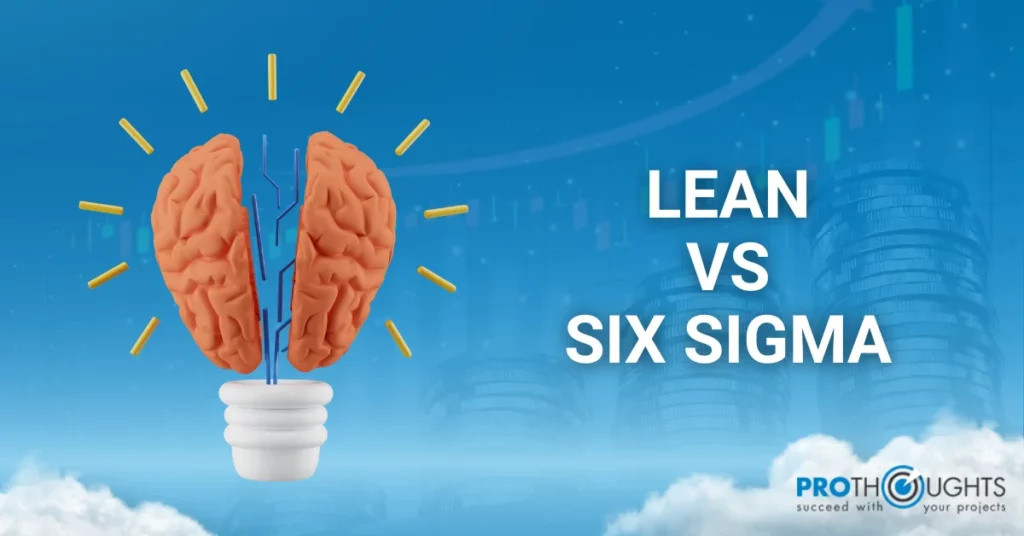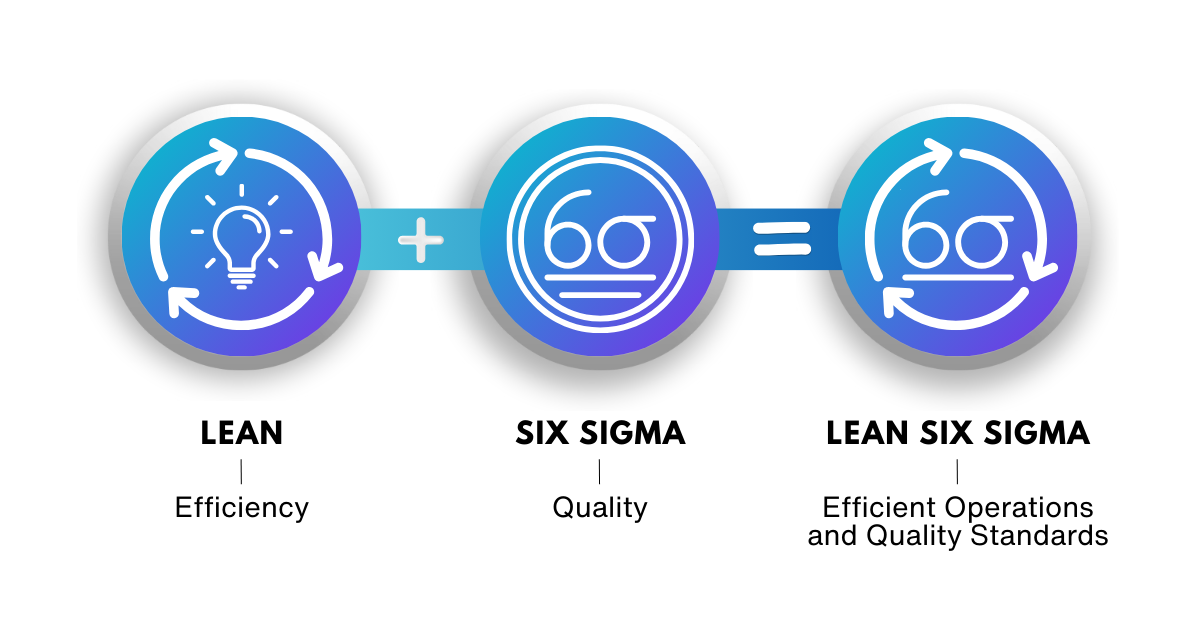
Lean and Six Sigma are amongst the most well-known approaches for optimizing business systems, cutting costs, and eliminating waste in production. Whether or not you are new to project management, you would often hear the terms used side by side. So much so, that these are often interlinked to one another. In essence, both methods share the same end goal to identify the root cause of waste and create an efficient system. Their difference lies in the way in which they approach these goals. So, the question arises: Lean vs Six Sigma – which approach will give you your ideal production standard? Let’s find out in this blog!
What Is Lean?
Lean is a set of practices aimed at improving efficiency, reducing waste, and enhancing the overall customer experience. It is a “Way of Thinking” rather than a specific framework. Lean thinking is concerned with using fewer resources thereby cutting costs, while also maximizing value. Needless to say, it is a continuous process, where the “Lean organization”
Lean was originally introduced by Henry Ford, as a vision to improve manufacturing to such an extent that processes flow seamlessly into one another. It was later adopted and tweaked by Toyota and came to be known as the Toyota Production System. The Toyota Production System is said to be the most efficient one across the globe.
What is Lean Methodology?
Lean methodology is the process of defining what the customer actually values. After that, it is tailoring and optimizing practices in such a way that you use fewer resources, less time, labor, and money and deliver EXACTLY what the customer envisions at a better quality. Lean project management also urges managers and team members to perform continuous experimentation to make the delivery process faster, and smoother, with minimum bottlenecks or inefficiencies.
Lean and Six Sigma both aim to minimize waste and improve product quality. But, the primary difference is how they approach this goal. Lean achieves the goal by targeting inefficiencies in the production cycle.. Taiichi Ohno from Toyota introduced areas where efficiency could take a toll as – Muda, Muri, and Mura. From the three terms, Muda means “Waste”. Muri means a situation where there is an excessive workload on the team which affects the pace of work. Mura stands for “skewed distribution of labor”.
Muda:
Lean identifies “7 Areas Of Waste”. These are:
- Transport: Relates to inefficient transportation of resources.
- Inventory: Waste occurs when there is too much inventory to process.
- Motion: Refers to inefficient transition between tasks.
- Waiting time: If one task team is idle due to dependency on another team, waste occurs.
- Overproduction: This happens when production exceeds demand.
- Overprocessing: When you spend too much time and resources to produce value that is unnecessary to the user.
- Defects: When your products are not up to the mark, and require additional resources to fix or replace them.
Later on, the authors of the famous book “The Machine that Changed the World” introduced another type of waste called Lost Talent. This type of “Muda” associates with the unused potential of team members. The goal of Lean methodology is to decrease Muda and remove bottlenecks to improve efficiency.
Muri:
When the workload is too high for the team to process, or if too much churning is expected out of machinery without downtime – Ohno labeled the situation as Muri. Under such a situation, the production cycle could halt completely due to the failure of machinery at any point or employee burnout. Assigning work in digestible chunks is the Lean way to ensure continuous productivity with enhanced efficiency.
Mura:
If your coworker is consistently getting more free time, while you work extra hours, it would evoke frustration. This imbalance would thereby hamper the efficiency of tasks. Moreover, with this consistent imbalance, there could be a rising bottleneck which would become a blaring problem in the near future.
Therefore, as per the principles of Lean methodology, the elimination of Muda, Muri, and Mura leads to a streamlined system that delivers faster and better.
What Is Six Sigma?
Six Sigma is a process improvement method that increases efficiency and minimizes errors by focusing on customer expectations. Any variation from the customer’s expectation of the product is deemed as a defect. The Six Sigma team then applies its practices to rectify the problem and create a product of premium quality for the user. The end goal of this methodology is to create products or services with less than 3.4 defects per million products or services produced.
Six Sigma was introduced by Bill Smith, an engineer at Motorola in the 1980’s. His idea was that if you get rid of existing variation, you can increase customer satisfaction and also increase your profits. Bill Smith’s theory worked wonders for Motorola. With Six Sigma adoption and its continuous application to reach just 3.4 defects per million opportunities, the company saved $16 Billion in revenue. Motorola later made the Six Sigma methodology public, and thereafter, companies like General Electric, Toshiba, Bank of America, and Intel have all adopted Six Sigma principles to see dramatic revenues as well. Six Sigma’s journey started with manufacturing, but now its adoption has branched out to all sorts of industries, including customer support, management, and service delivery.
What Does Six Sigma Mean?
We understood the origins of Six Sigma and its goal of minimizing waste. But where did the term “Six Sigma” come from? Just like how “Lean” got its name from its process of “trimming down” the extra work and waste, Six Sigma came from the statistical Greek symbol “sigma” or “σ.” Sigma is a statistical term for measuring process deviation from the process mean or target. One Sigma symbolizes a single standard deviation from the mean. Similarly, Six Sigma means that 6 such deviations from the mean.
The idea is that the more the number of standard deviations between the process average and acceptable process limits, the less likely that the process performs beyond the acceptable process limits, leading to a defect. Of course, more than 6 sigmas is an ideal case scenario. However, Six Sigma practitioners gained the belief that a 6σ process is good enough to be reliable in most situations.
What is the Six Sigma Methodology?
The Six Sigma methodology uses one of the two 5-step approaches to reduce defects. One is abbreviated as DMAIC and another as DMADV. Let’s look at both in detail:
DMAIC:
DMAIC stands for Define, Measure, Analyze, Improve, and Control. This 5-step process is appropriate for manufacturing and service delivery. As the name illustrates “Improve”, which means that DMAIC is applicable to processes that are already existing and need improvements to reduce waste. Here is the description of each step of Six Sigma quality control with the DMAIC method:
- Define: We identify the problem in the process and define the areas it affects.
- Measure: In this step, we measure the outcomes produced by the current practices in place. We find the scope for improvements by marking out what isn’t working.
- Analyze: As the name suggests, we analyze the data we have to get to the root of the issues we pointed out in the first two steps.
- Improve: We build an improvement strategy and apply it to the process. Then, we follow up with testing procedures to tweak the added improvements as necessary.
- Control: The Six Sigma teams need to constantly monitor the process after the introduction of the changes. Continuous refinement needs to be made to stay on top of the improvement curve. Also, they should ensure that the solution is maintained in the future as well.
DMADV:
DMADV stands for Define, Measure, Analyze, Design, and Verify. Since DMAIC has a limitation of only applying to existing processes, the DMADV comes in handy for constructing Six Sigma-proof new functions. DMADV comes into the picture when existing processes do not meet customer expectations even after optimization. Hence, there is a need to completely re-design the process or develop a new one entirely. Below is the breakdown of each step in the DMADV approach to Six Sigma methodology:
- Define: This step is the same as DMAIC. The Six Sigma practitioner identifies the problem at hand and the areas it affects.
- Measure: Here we measure the outcomes of the previous processes and the extent of defects it produced. We also measure the customer requirements and chart it out for the next step – Analysis.
- Analyze: We analyze the data from the previous step and develop a conceptual solution targeting every loophole.
- Design: This stage is completely different from what we saw for DMAIC. Here, we construct a design prototype from our analysis, to solve the problem.
- Verify/Validate: We verify the constructed prototype for the new function, test it, and many refinements as we go.
Lean Vs Six Sigma: What’s the Difference?
Lean and Six Sigma share the same goal: to eliminate waste and maximize value. Their difference lies in the approach they take to achieve this goal. In the below table, we compare Lean vs Six Sigma, based on all their distinguishing factors:
| Factor | Lean | Six Sigma |
|---|---|---|
| Fundamental Difference | Lean is a Mindset. | Six Sigma is a Methodical Program. |
| Perspective | Lean views waste in the form of production inefficiencies and areas for cutting costs. | Six Sigma views waste as the amount of variation from customer expectations. |
| Application | Production Environments. | Production & Non-production environments. |
| Process Improvement | 5 Whys, A3 Problem Solving, Continuous Flow, Gemba Walks, Kanban, Kaizen, Value Stream Mapping, Pareto Analysis, etc. | DMAIC (Define, Measure, Analyze, Improve, and Control) & DMADV (Define, Measure, Analyze, Design, Verify). |
| Approach | Identify and eliminate bottlenecks in the production cycle. | Eliminate any discrepancy with the customer’s expectations. |
| Inculcation | Lean is worked on from the ground up, by inculcating Lean Thinking in the organizational culture. | Can be inculcated with the help of Six Sigma professionals of different levels. |
Both Lean and Six Sigma have shown exemplary results to the organizations that have applied them. But, what if you harness both approaches? How can you take elements from both Lean and Six Sigma to solve problems in your business context? This is where a hybrid of Lean and Six Sigma comes into the picture – Enter Lean Six Sigma!
Lean Vs Six Sigma to Lean Six Sigma
We looked at the intricacies of both process improvement methods in this blog. Lean and Six Sigma are essentially two aspects of the same philosophy. However, the former is process-based while the latter is statistic-based. Both, Lean and Six Sigma are valuable approaches that show dramatic improvement in product quality which in turn leads to profits. Businesses adopting either of these have a high ROI in general. However, harnessing both seems like an ideal choice for most businesses because any enterprise demands both – a nimble system and high customer satisfaction. So, Lean vs Six Sigma has evolved to become Lean Six Sigma today.
What Is Lean Six Sigma?
Lean Six Sigma is a powerful hybrid of Lean and Six Sigma (as the name obviously suggests). It combines the best of Lean (efficiency) with the best of Six Sigma (quality and consistency). Thus, with Lean Six Sigma, the organizations deliver value while maintaining quality standards, with the help of efficient operations. This results in the finer quality of products and services to the end user, which means better acceptance in the market. Since Lean Six Sigma targets both pain points, it is now a widely adopted approach in the industry. Adopters of Lean Six Sigma come from almost any industry niche – ranging from healthcare to manufacturing.
To apply Lean Six Sigma, most organizations start with applying the Lean Mindset first. Once the system is efficient and the bottlenecks are minimal, then begins the Six Sigma application. Since Six Sigma is a more technical approach that requires bandwidth, it is best to apply it when the process flow is already optimal and there is only the product/problem to focus on. Both methodologies are carried out simultaneously, with continuous improvements to stay ahead of the curve at all times.
Cumulated benefits of Lean Six Sigma:
- Increase in Profits
- Decrease in Costs
- Improved Efficiency & Quality
- Higher Customer Satisfaction
- Better Company Culture
With a thorough understanding of your business and products, therefore, you can choose to adopt either Lean or Six Sigma or just Lean Six Sigma!
Conclusion of the Lean vs Six Sigma debate:
To conclude the Lean vs Six Sigma debate, we would say that Lean is easier to implement and works in most business initiatives. This is because it is a form of continuous improvement methodology to guide innovation and adaptation. Six Sigma, on the other hand, is a methodical framework ideal for complex initiatives. Six Sigma is the best choice for businesses with low-risk tolerance and safety hazards (as we explained in the blog). Since Lean focuses on the process, and Six Sigma on the outcome, harnessing both has become the ideal path these days. Most business leaders pick the suitable parts of both approaches to tailor a strategy that works just right for them!
Want to learn how to get the best out of ALL the existing frameworks and methodologies? Disciplined Agile can come in handy for you. Disciplined Agile allows you to tailor practices from hundreds of different methods to suit your specific business situation. No more “this vs. that” then right?
Get Certified! Place an inquiry for the Disciplined Agile Senior Scrum Master (DASSM) certification course today!




